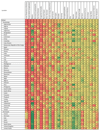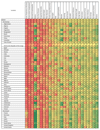Global and National Burden of Diseases and Injuries Among Children and Adolescents Between 1990 and 2013: Findings From the Global Burden of Disease 2013 Study
- PMID: 26810619
- PMCID: PMC5076765
- DOI: 10.1001/jamapediatrics.2015.4276
Global and National Burden of Diseases and Injuries Among Children and Adolescents Between 1990 and 2013: Findings From the Global Burden of Disease 2013 Study
Abstract
Importance: The literature focuses on mortality among children younger than 5 years. Comparable information on nonfatal health outcomes among these children and the fatal and nonfatal burden of diseases and injuries among older children and adolescents is scarce.
Objective: To determine levels and trends in the fatal and nonfatal burden of diseases and injuries among younger children (aged <5 years), older children (aged 5-9 years), and adolescents (aged 10-19 years) between 1990 and 2013 in 188 countries from the Global Burden of Disease (GBD) 2013 study.
Evidence review: Data from vital registration, verbal autopsy studies, maternal and child death surveillance, and other sources covering 14,244 site-years (ie, years of cause of death data by geography) from 1980 through 2013 were used to estimate cause-specific mortality. Data from 35,620 epidemiological sources were used to estimate the prevalence of the diseases and sequelae in the GBD 2013 study. Cause-specific mortality for most causes was estimated using the Cause of Death Ensemble Model strategy. For some infectious diseases (eg, HIV infection/AIDS, measles, hepatitis B) where the disease process is complex or the cause of death data were insufficient or unavailable, we used natural history models. For most nonfatal health outcomes, DisMod-MR 2.0, a Bayesian metaregression tool, was used to meta-analyze the epidemiological data to generate prevalence estimates.
Findings: Of the 7.7 (95% uncertainty interval [UI], 7.4-8.1) million deaths among children and adolescents globally in 2013, 6.28 million occurred among younger children, 0.48 million among older children, and 0.97 million among adolescents. In 2013, the leading causes of death were lower respiratory tract infections among younger children (905.059 deaths; 95% UI, 810,304-998,125), diarrheal diseases among older children (38,325 deaths; 95% UI, 30,365-47,678), and road injuries among adolescents (115,186 deaths; 95% UI, 105,185-124,870). Iron deficiency anemia was the leading cause of years lived with disability among children and adolescents, affecting 619 (95% UI, 618-621) million in 2013. Large between-country variations exist in mortality from leading causes among children and adolescents. Countries with rapid declines in all-cause mortality between 1990 and 2013 also experienced large declines in most leading causes of death, whereas countries with the slowest declines had stagnant or increasing trends in the leading causes of death. In 2013, Nigeria had a 12% global share of deaths from lower respiratory tract infections and a 38% global share of deaths from malaria. India had 33% of the world's deaths from neonatal encephalopathy. Half of the world's diarrheal deaths among children and adolescents occurred in just 5 countries: India, Democratic Republic of the Congo, Pakistan, Nigeria, and Ethiopia.
Conclusions and relevance: Understanding the levels and trends of the leading causes of death and disability among children and adolescents is critical to guide investment and inform policies. Monitoring these trends over time is also key to understanding where interventions are having an impact. Proven interventions exist to prevent or treat the leading causes of unnecessary death and disability among children and adolescents. The findings presented here show that these are underused and give guidance to policy makers in countries where more attention is needed.
Conflict of interest statement
Conflict of Interest Disclosures: Dr. Kassebaum reports personal fees and non-financial support from Vifor Pharmaceuticals, Axon Communications LLC and Merck & Co outside the submitted work. KPG was awarded the NHMRC-Gustav Nossal Postgraduate Award sponsored by CSL; this award is peer reviewed and CSL had no part in selecting the awardee. Prof. Lotufo reports honoraria (modest) from Abbvie for one lecture. Walter Mendoza is program analyst at the UNFPA country office in Peru, which not necessarily endorses the study. Prof. Santos reports receiving a grant from São Paulo Research Foundation/FAPESP (Brazilian governmental research agency) for research purposes. In the past 3 years, Dr. Stein has received research grants and/or consultancy honoraria from AMBRF, Biocodex, Cipla, Lundbeck, National Responsible Gambling Foundation, Novartis, Servier, and Sun. No other conflicts are reported.
Figures






Comment in
-
The Grand Divergence in Global Child Health: Confronting Data Requirements in Areas of Conflict and Chronic Political Instability.JAMA Pediatr. 2016 Mar;170(3):195-7. doi: 10.1001/jamapediatrics.2015.4275. JAMA Pediatr. 2016. PMID: 26809944 No abstract available.
References
-
- United Nations Children's Fund (UNICEF) The State of the World’s Children 2011. Adolescence: An age of opportunity. [Accessed May 28, 2015];2011 http://www.unicef.org/sowc2011/pdfs/SOWC-2011-Main-Report_EN_02092011.pdf.
-
- Murray CJL, Ezzati M, Flaxman AD, et al. GBD 2010: design, definitions, and metrics. The Lancet. 2013;380(9859):2063–2066. - PubMed
-
- Vos T, Barber RM, Bell B, et al. Global, regional, and national incidence, prevalence, and YLDs for 301 acute and chronic diseases and injuries for 188 countries, 1990-2013: a systematic analysis for the Global Burden of Disease Study 2013. Lancet. 2015 doi: 10.1016/S0140-6736(15)60692-4. - DOI - PMC - PubMed
Publication types
MeSH terms
Grants and funding
- 5T32HL007093-40/HL/NHLBI NIH HHS/United States
- T32 HL007093/HL/NHLBI NIH HHS/United States
- MC_U147585827/MRC_/Medical Research Council/United Kingdom
- MC_U147585819/MRC_/Medical Research Council/United Kingdom
- MR/L003120/1/MRC_/Medical Research Council/United Kingdom
- IA/CPHI/14/1/501497/WTDBT_/DBT-Wellcome Trust India Alliance/India
- RP-PG-0407-10184/DH_/Department of Health/United Kingdom
- MR/K006525/1/MRC_/Medical Research Council/United Kingdom
- MC_U147585824/MRC_/Medical Research Council/United Kingdom
- 089963/Z/09/Z/WT_/Wellcome Trust/United Kingdom
- MC_PC_13043/MRC_/Medical Research Council/United Kingdom
- RG/08/014/24067/BHF_/British Heart Foundation/United Kingdom
- G0400491/MRC_/Medical Research Council/United Kingdom
- 089963/WT_/Wellcome Trust/United Kingdom
LinkOut - more resources
Full Text Sources
Other Literature Sources
Medical

